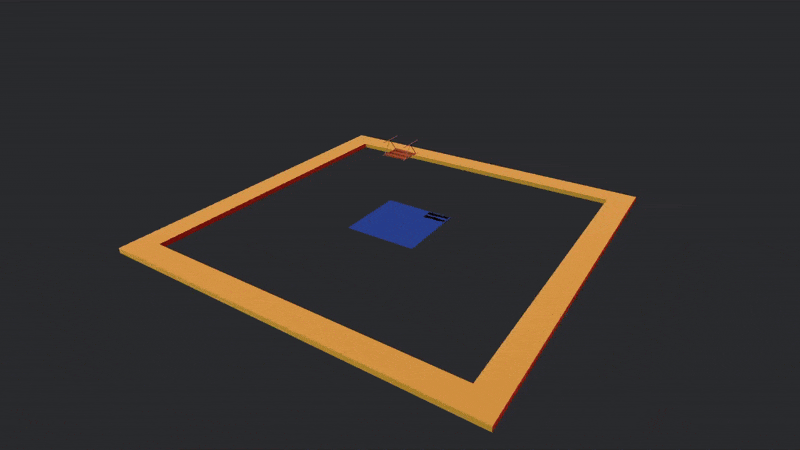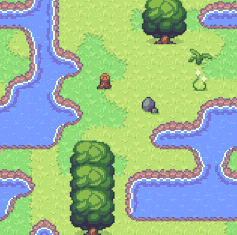5 releases (breaking)
| 0.5.0 | Apr 3, 2025 |
|---|---|
| 0.4.0 | Nov 8, 2024 |
| 0.3.0 | Nov 7, 2024 |
| 0.2.0 | May 17, 2024 |
| 0.1.0 | Jan 19, 2024 |
#251 in Game dev
25 downloads per month
Used in bevy_ghx_proc_gen
145KB
2K
SLoC
A Rust library for 2D & 3D procedural generation with Model synthesis/Wave function Collapse, also available for the Bevy engine.
With Model synthesis/Wave function Collapse, adjacency constraints are provided as an input to the algorithm, and internally, a solver (AC-4 in this case), will try to generate a solution with satisfies those constraints.
Altough it can be applied to do texture synthesis (mainly with bitmaps), ghx_proc_gen focuses more on grid-based use-cases such as terrain or structures generation with the following goals of being:
- Fast. As much as possible, the core of the algorithm is implemented to be fast; if and when an API operation may hurt performances, this will be clearly visible.
- Output format agnostic. Models are just numbers in the core algorithm, and how you interpret them in the generator's results is up to you (3d objects, 2d sprites, texts, colors, ...).
- Ergonomic
- Well documented (
#![warn(missing_docs)])
Quickstart
cargo add ghx_proc_gen
The building pieces of a generation are called Models, and adjacency constraints are defined with Socket. Every model has one or more socket on each of his sides.
Connections are defined between sockets, and allows models with connected sockets on opposite sides to be neighbours.
Let's build a chessboard pattern:
- Start by creating
Rulesfor the algorithm:
// A SocketCollection is what we use to create sockets and define their connections
let mut sockets = SocketCollection::new();
// For this example, we will only need two sockets
let (white, black) = (sockets.create(), sockets.create());
// With the following, a `white` socket can connect to a `black` socket and vice-versa
sockets.add_connection(white, vec![black]);
let mut models = ModelCollection::<Cartesian2D>::new();
// We define 2 very simple models: a white tile model with the `white` socket on each side
// and a black tile model with the `black` socket on each side
models.create(SocketsCartesian2D::Mono(white));
// We keep the black model for later
let black_model = models.create(SocketsCartesian2D::Mono(black)).clone();
// We give the models and socket collection to a RulesBuilder and get our Rules
let rules = RulesBuilder::new_cartesian_2d(models, sockets).build().unwrap();
- Create a
GridDefinition:
// Like a chessboard, let's do an 8x8 2d grid
let grid = CartesianGrid::new_cartesian_2d(8, 8, false, false);
- Create a
Generator:
// There many more parameters you can tweak on a Generator before building it, explore the API.
let mut generator = GeneratorBuilder::new()
.with_rules(rules)
.with_grid(grid)
// Let's ensure that we make a chessboard, with a black square bottom-left
.with_initial_nodes(vec![(0, black_model)]).unwrap()
.build()
.unwrap();
- Get a result:
// Here we directly generate the whole grid, and ask for the result to be returned.
// The generation could also be done iteratively via `generator.select_and_propagate()`, or the results could be obtained through an `Observer`
let chess_pattern = generator.generate_collected().unwrap();
By simply printing the results in a terminal we obtain:
let icons = vec!["◻️ ", "⬛"];
for y in 0..chess_pattern.grid().size_y() {
for x in 0..chess_pattern.grid().size_x() {
print!("{}", icons[chess_pattern.get_2d(x, y).model_index]);
}
println!();
}

For more information, check out the main crate documentation or all the examples.
More details on the API
Model variations
To facilitate the rules-definition step, some models variations can be created for you automatically. This will take care of rotating all the model sockets properly.
Let's take this rope-bridge model as an example:

let bridge_model = SocketsCartesian3D::Simple {
x_pos: bridge_side,
x_neg: bridge_side,
z_pos: bridge,
z_neg: bridge,
y_pos: bridge_top,
y_neg: bridge_bottom,
}
.to_template()
.with_additional_rotation(ModelRotation::Rot90)
With the above declaration, we declared our base model (with Rot0 allowed by default), and allowed an extra rotation of Rot90 degrees. Internally, when building the Rules, two models variations will be created.
When retrieving generated results, you get ModelInstances which reference the original model index as well as the ModelRotation applied to it.
You can also manually create rotated variations of a model: bridge_model.rotated(ModelRotation::Rot180) and use a different asset for it, change its weight, etc. [documentation].
Coordinate systems & axis
ghx_proc_gen uses a right-handed coordinate system. But the rotation axis used to create model variations can vary:
- When using
Cartesian3D, it defaults toY+and can be customized on aRulesBuilder. - When using
Cartesian2D, the rotation axis is fixed toZ+[documentation].
For Bevy, see the Unofficial bevy Cheatbook.
Socket connections
As seen in the quickstart, socket connections are declared with a SocketCollection [documentation].
Note that sockets connections situated on your rotation axis should be handled differently if they are used on a model with generated rotations variations.

Rotating model 2 in the above figure causes its top socket (here B) to be different. For this example, we could use:
// a socket `B` can only be connected to another `B` if their **relative** rotation is 0°
sockets.add_constrained_rotated_connection(B, vec![ModelRotation::Rot0], vec![B]);
Let's imagine that models 1 and 2 had different sockets declarations on their top and bottom respectively, and that these sockets were only compatible when their relative rotation was 0° or 180°:
// a socket `model_2_top` can only be connected to another `model_1_bottom`
// if their **relative** rotation is 0° or 180°
sockets.add_constrained_rotated_connection(
model_2_top,
vec![ModelRotation::Rot0, ModelRotation::Rot180],
vec![model_1_bottom]
);
See for axample the bridge_start_bottom socket in the canyon example, which can only face outwards from a rock.
Generator-human interaction
A generation can be customized by the user: by setting specific initial values via calls to with_initial_nodes/with_initial_grid, or by directly interacting with an on-going generation wia calls to set_and_propagate. [bevy plugin video example].
This is used by the ProcGenDebugPlugin.
Observers
Instead of collecting the results of a Generator call direclty, you can retrieve them via an Observer connected to a Generator [documentation].
This is used by the ProcGenDebugPlugin.
Grid loop
Grids can be configured to loop on any axis, this is set on their GridDefinition [documentation].
Cargo features
Find the list and description in ghx_proc_gen/cargo.toml
-
models-names[default]: When creating models, you can register a name for them with thewith_namefunction. With the feature disabled, the function does nothing. But when enabled, the name of your models will be accessible at runtime (and visible in the debug traces if enabled). -
debug-traces: Disabled by default, this feature will add traces (using thetracingcrate) to the core algorithm of the crate. Since some of those logs are on the hot path, the feature should only be enabled in debug.The log level can be configured by the user crates (
tracing::level, theLogPluginfor Bevy, ...). -
bevy: Disabled by default, enabling it simply derivesComponenton common structs of the crate. -
reflect: Disabled by default, enabling it simply derivesReflecton common structs of the crate.
For Bevy users
See the bevy_ghx_proc_gen crate which uses and exposes ghx_proc_gen, as well as additional plugins and utilities dedicated to Bevy.
cargo add bevy_ghx_proc_gen
Examples
| Grid coordinate system | Assets | Engine | Plugin | Camera | |
|---|---|---|---|---|---|
Chessboard |
Cartesian2D | Unicode | None | N/A | N/A |
Unicode terrain |
Cartesian2D | Unicode | None | N/A | N/A |
Bevy-chessboard |
Cartesian2D | Procedural meshes | Bevy | ProcGenSimplePlugin | 3D |
Pillars |
Cartesian3D | .glb | Bevy | ProcGenDebugPlugin | 3D |
Tile-layers |
Cartesian3D | .png | Bevy | ProcGenDebugPlugin | 2D |
Canyon |
Cartesian3D | .glb | Bevy | ProcGenDebugPlugin | 3D |
Examples videos for unicode-terrain, pillars, tile-layers & canyon are slowed down in order to see the generation progress
[Command-line] Chessboard example
cargo run --example chessboard
Simple standalone example, the same as in the quickstart section.
[Command-line] Unicode terrain example
cargo run --example unicode-terrain
Simple standalone example which generates a top-down 2d terrain and displays it in the terminal with unicode characters.
https://github.com/Henauxg/ghx_proc_gen/assets/19689618/6a1108af-e078-4b27-bae1-65c793ef99c1
[Bevy] Bevy chessboard example
cargo run --example bevy-chessboard
Simplest Bevy example, the same as in the bevy quickstart section.
[Bevy] Pillars example
cargo run --example pillars
This example generates multiple pillars of varying sizes in an empty room. Its rules are really simple with only 4 models: a void block, a pillar base, a pillar core and a pillar top.
https://github.com/Henauxg/ghx_proc_gen/assets/19689618/7beaa23c-df88-47ca-b1e6-8dcfc579ede2
[Bevy] Tile-layers example
cargo run --example tile-layers
This example uses Bevy with a 2d Camera but generates a top-down tilemap by combining multiple z-layers, so the grid and rules used are still 3d.
https://github.com/Henauxg/ghx_proc_gen/assets/19689618/3efe7b78-3c13-4100-999d-af07c94f5a4d
[Bevy] Canyon example
cargo run --example canyon
This example generates a canyon-like terrain with some animated windmills.
https://github.com/Henauxg/ghx_proc_gen/assets/19689618/25cbc758-3f1f-4e61-b6ed-bcf571e229af
Misc
Rules-writing tips:
- Start simple, then add complexity (new models, sockets and connections) iteratively. Adding one model can have a huge influence on the generation results, and may require weights tweaks.
- Don't hesitate to define as many sockets as needed. Sockets onyl exist before the
Rulesare fully created, and are optimized away after. - Changing the Node selection heuristic may drastically change the generated results.
- On rectangle grids, diagonals constraints are harder and need intermediary models.
- There are often more than one way to achieve a particular result, and WFC/Model Synthesis shines when combined with other tools & effects. In particular you might find it useful to do some post-processing on the generated results (adding supports, combining models, ...).
Limitations:
-
Generation size can quickly become an issue. For now, when the generator encounters an error (a contradiction between the rules and the state of a node), the generation restarts from the beginning.
There are some ways to lessen this problem, such as backtracking during the generation and/or modifying in parts. See Model Synthesis and Modifying in Blocks by BorisTheBrave or Ph.D. Dissertation, University of North Carolina at Chapel Hill, 2009 by P.Merell.
Why "ghx" ?
- It serves as a namespace to avoid picking cargo names such as
proc_genorbevy_proc_gen
Credits
Thanks to:
- Paul Merrel for the Model Synthesis algorithm & implementation
- Maxim Gumin for the Wave Function Collapse algorithm & implementation
- BorisTheBrave for his C# library DeBroglie and the article series on his website
License
Code
ghx-proc-gen is free and open source. All code in this repository is dual-licensed under either:
- MIT License (LICENSE-MIT or http://opensource.org/licenses/MIT)
- Apache License, Version 2.0 (LICENSE-APACHE or http://www.apache.org/licenses/LICENSE-2.0)
at your option.
Unless you explicitly state otherwise, any contribution intentionally submitted for inclusion in the work by you, as defined in the Apache-2.0 license, shall be dual licensed as above, without any additional terms or conditions.
Assets
- Assets of the
pillarsandcanyonexamples were made for these examples by Gilles Henaux, and are availabe under CC-BY-SA 4.0 - Assets in the
tile-layersexample are "16x16 Game Assets" by George Bailey available on OpenGameArt under CC-BY 4.0
Dependencies
~3–17MB
~222K SLoC

